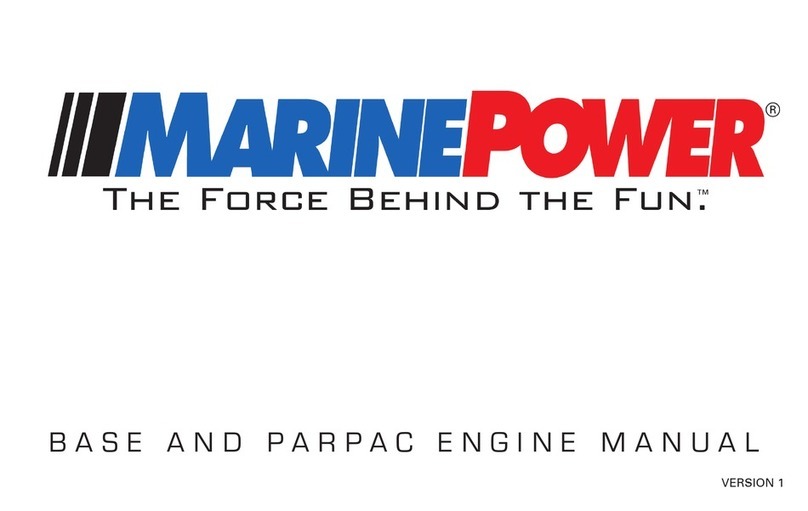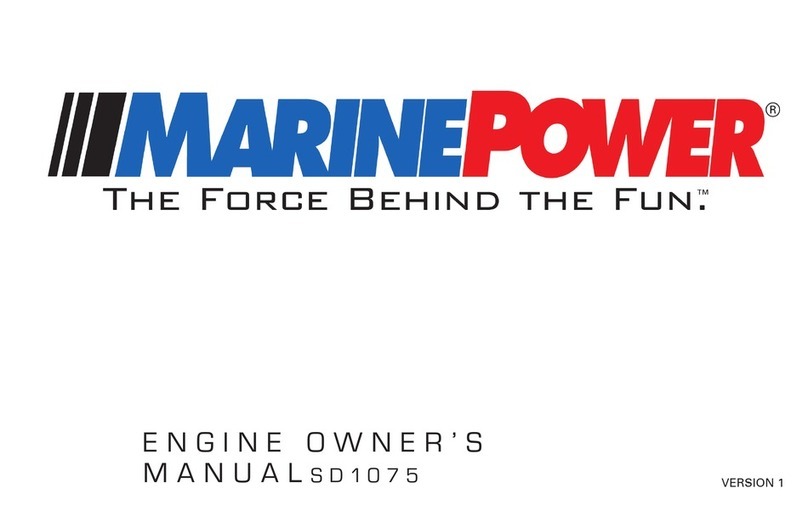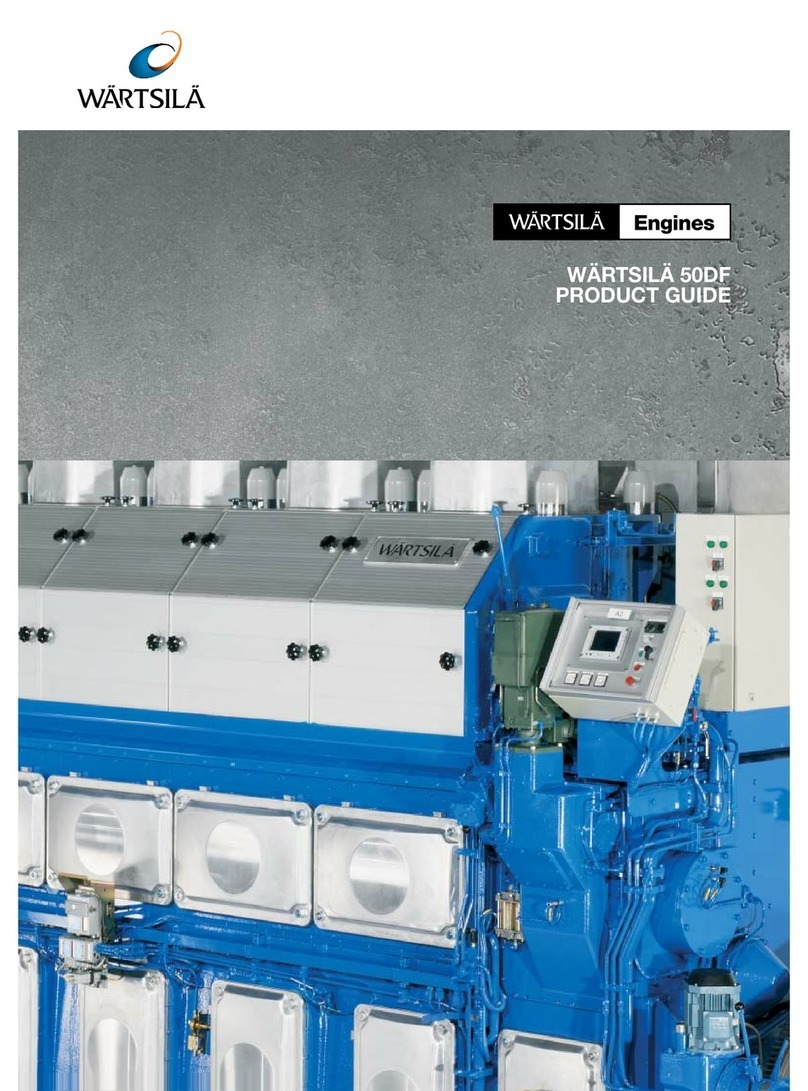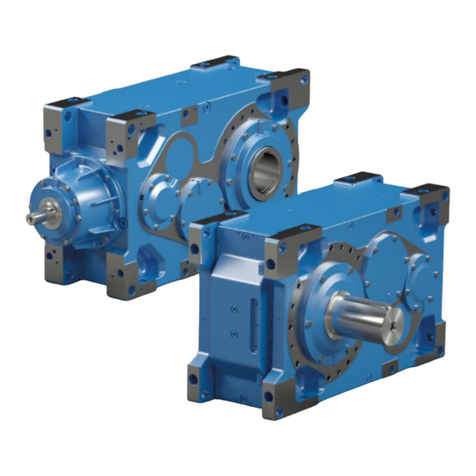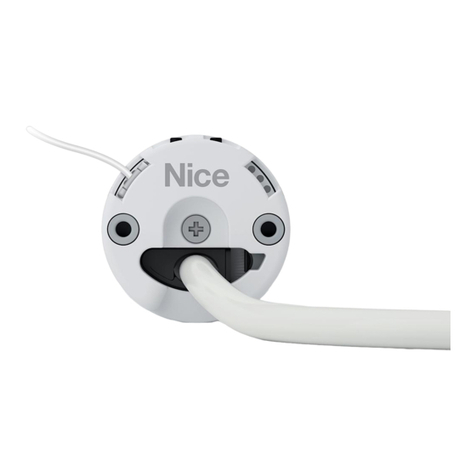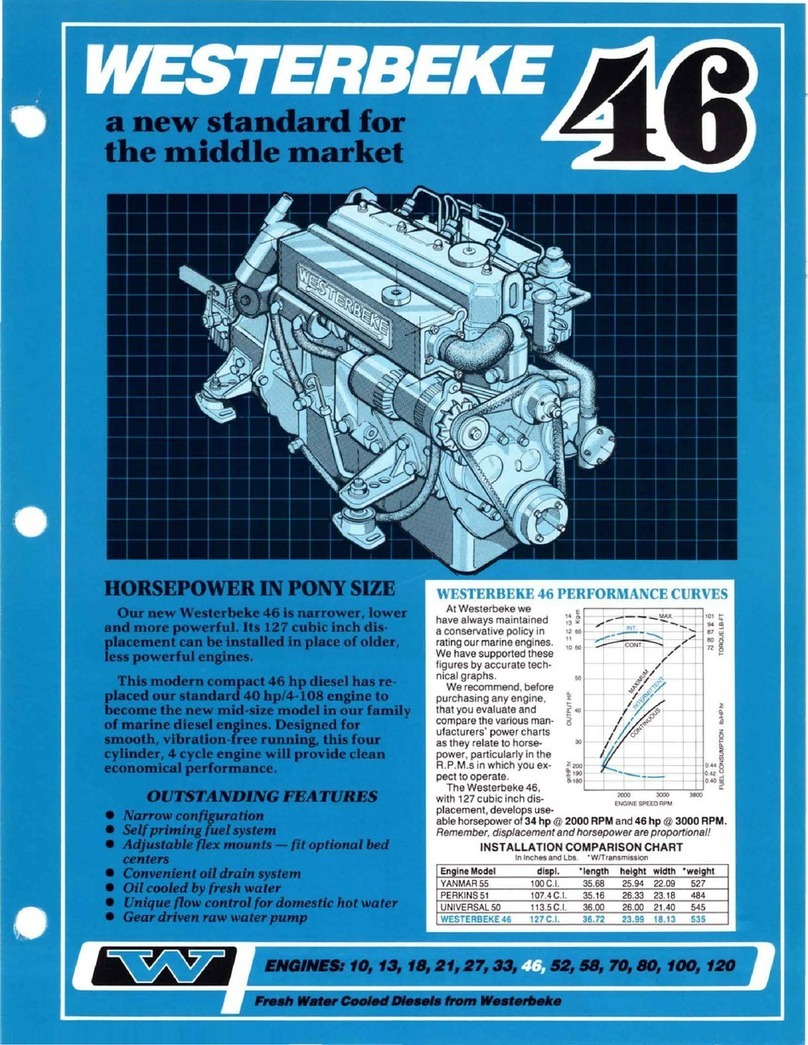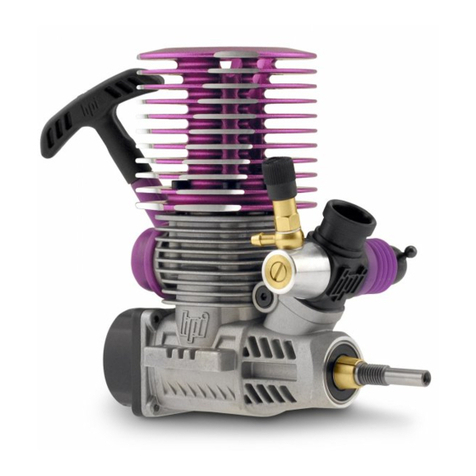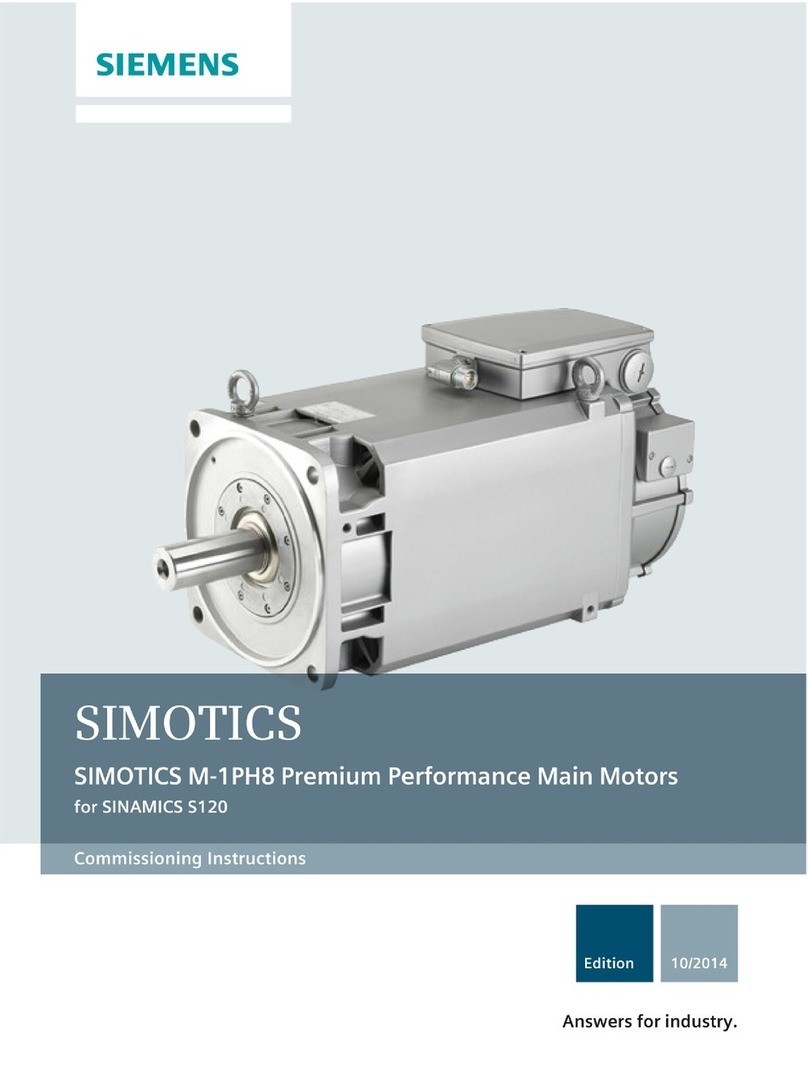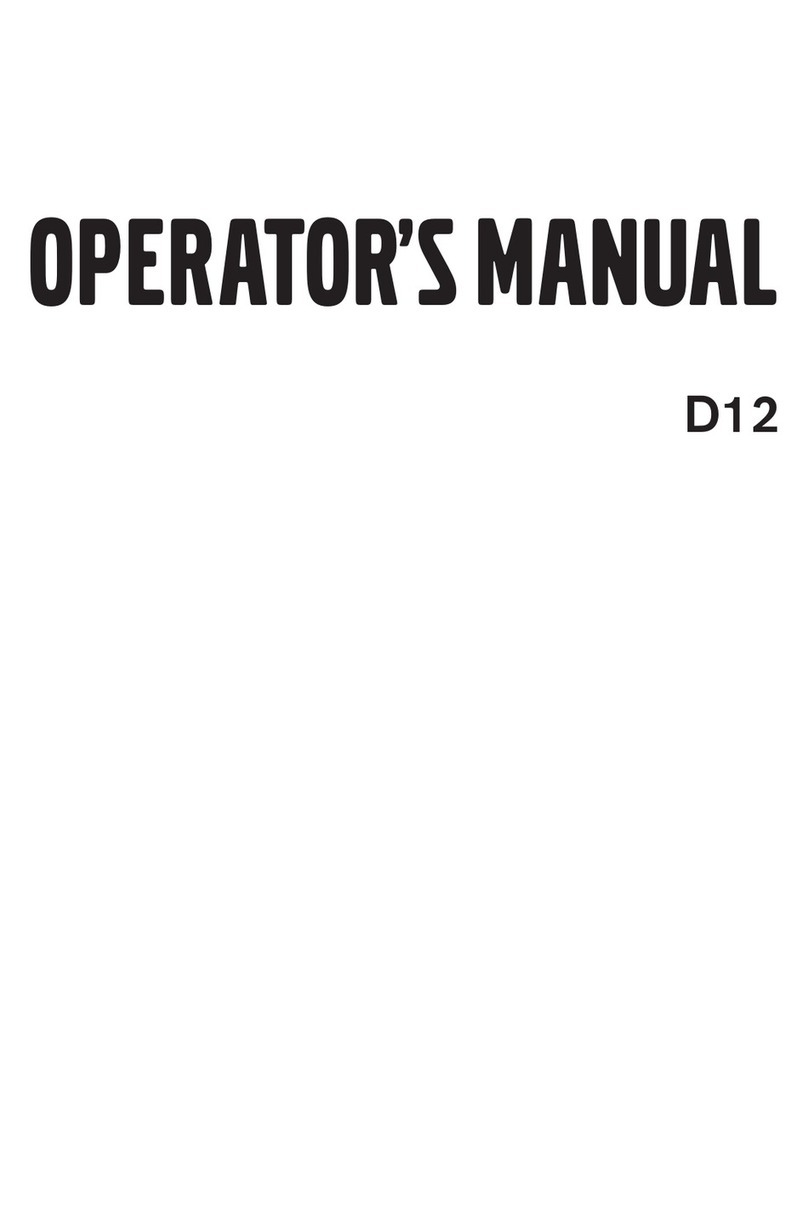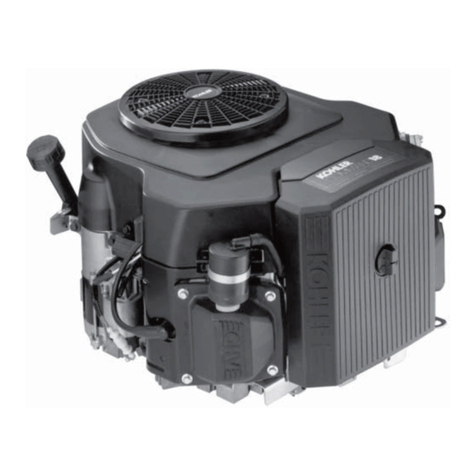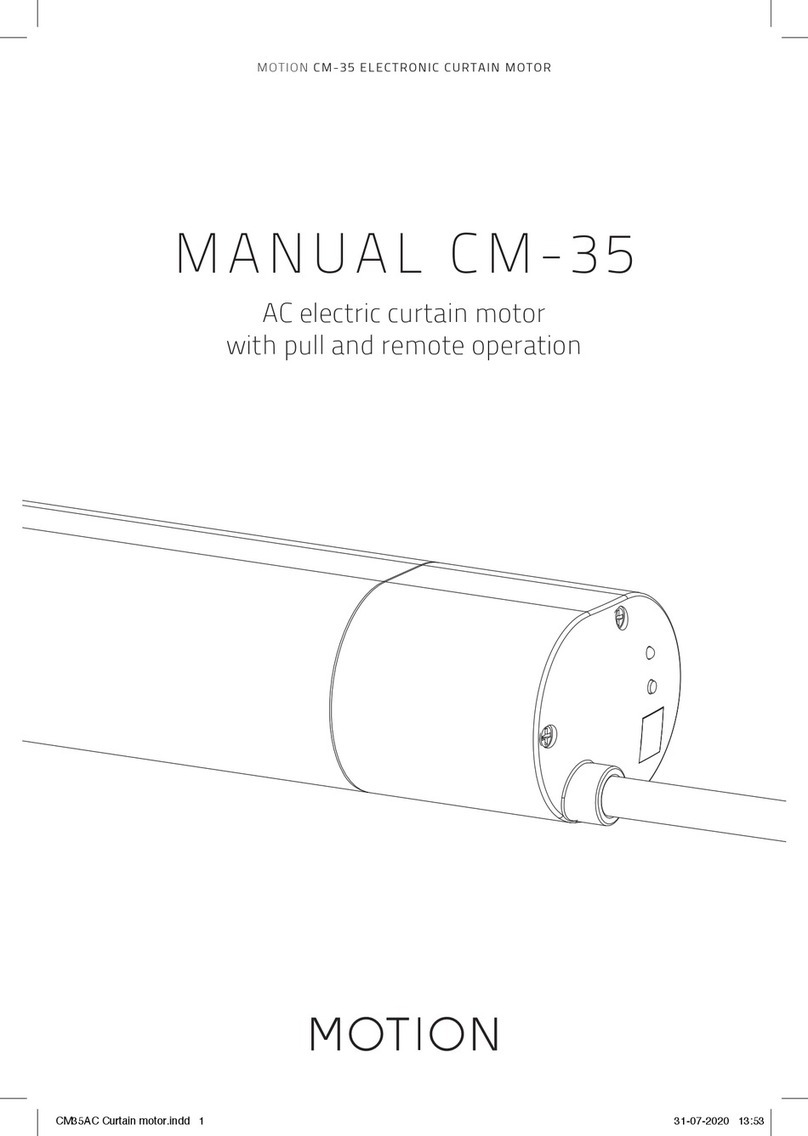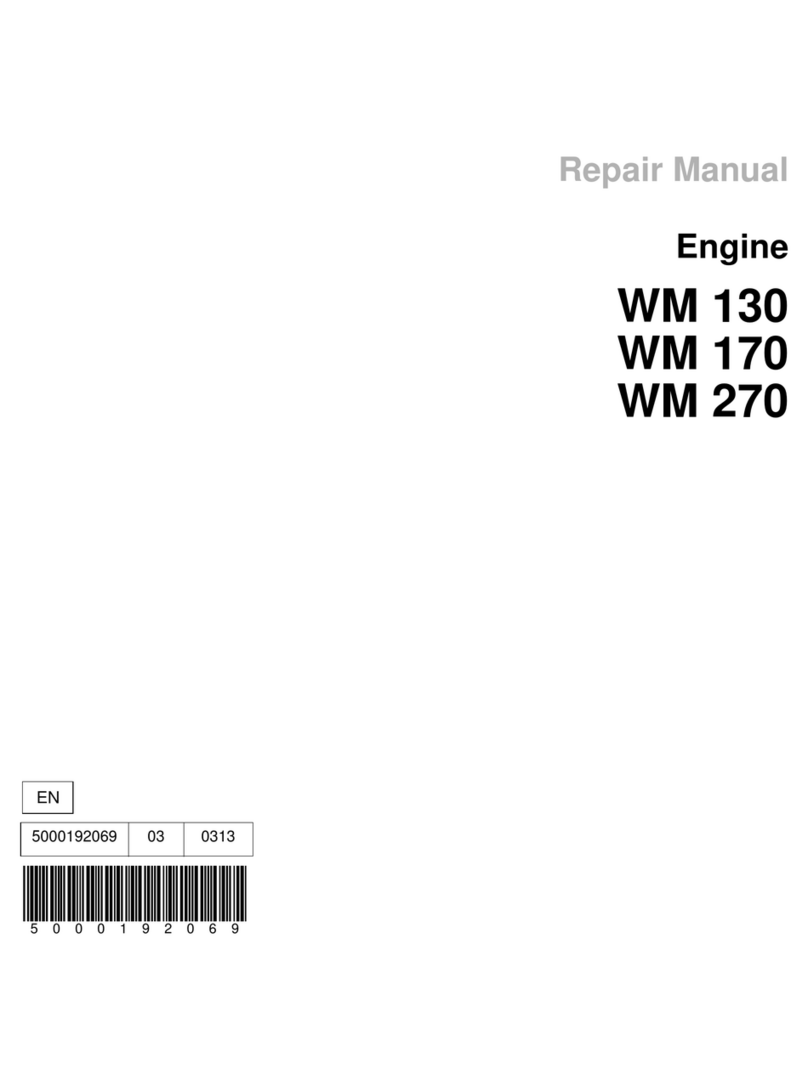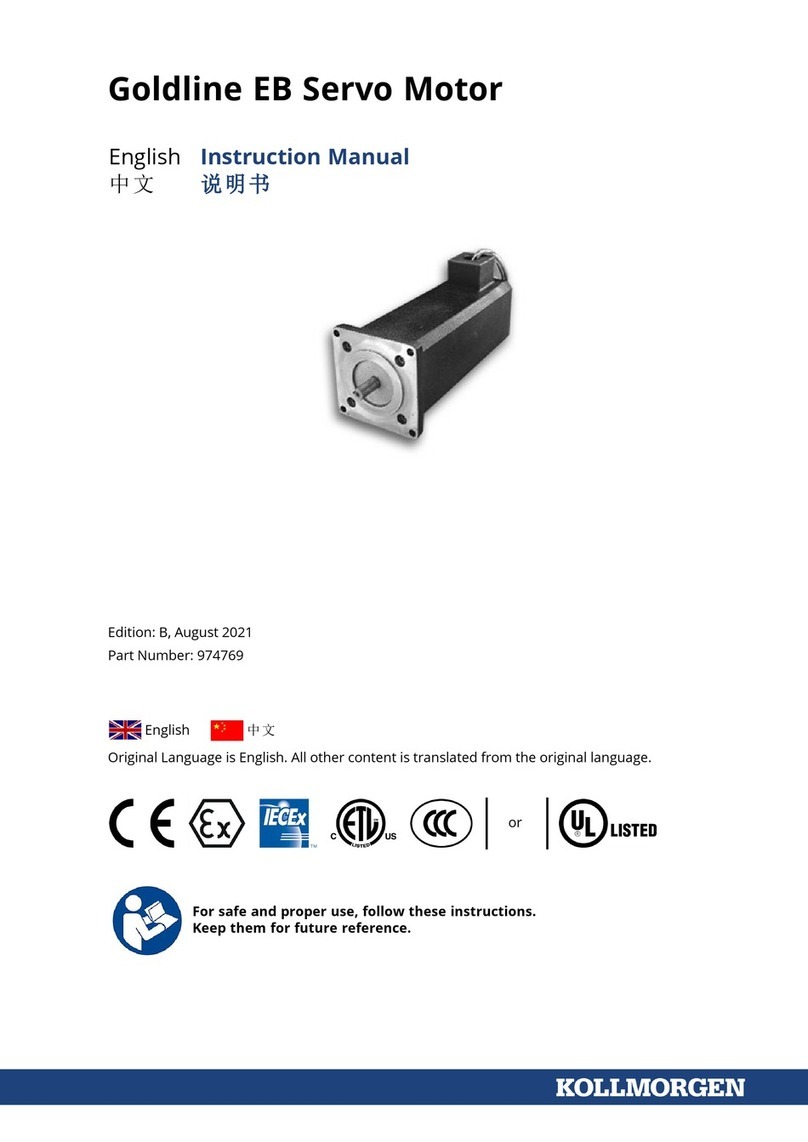Marine Power 4.3 VORTEC MPI User manual

ENGINE OWNER’S MANUAL
VERSION 3

i www.MarinePowerUSA.com
Table of Contents
Section 1: introduction
ProPosition 65..............................................................1
safety Warnings .........................................................1
rePlacement Parts........................................................1
safe Boating ................................................................2
Warranty................................................................ 2-5
Section 2: Safe Boating
carBon monoxide exPosure...........................................6
Section 3: engine identification
engine tyPe ..................................................................7
model sPecifications.....................................................8
Section 4: electronic Sequential fuel injection
information ....................................................................9
Section 5: engine alarmS and inStrumentation
digital alarms ...........................................................10
instrumentation .........................................................11
Section 6: SSVec fuSe and relay encloSure ....... 12-15
Section 7: PrecautionS
oil level ....................................................................16
Hydrolock..................................................................16
Section 8: engine oPerating inStructionS
gasoline requirements................................................17
oil requirements ........................................................17
starting engine efi ....................................................17
engine Break-in/25 Hour insPection...................... 17-18
Section 9: Winterization
4.3/5.7l raW Water cooled engines ..........................19
full closed cooled engines.........................................20
Half closed cooled engines .................................. 21-22
full closed inBoard Jet engines..................................23
Section 10: engine maintenance
scHeduled maintenance By oWner...............................24
scHeduled maintenance By qualified tecHnician ...........25
crankcase oil cHange ................................................26
oil filters ..................................................................27
flame arrestor ..........................................................28
g-force fuel system ..................................................28
Battery caBles ...........................................................29
multiPle engine Battery Precautions - efi ...................29
alternator Belt tension..............................................29
sea Water PumP imPeller rePlacement ........................29
closed cooling system ...............................................30
filling closed cooling system............................... 30-31
Section 11: engine diagnoSticS and codeS............ 32-34
Section 12: trouBle Shooting
engine Will not turn over ........................................35
engine cranks But Will not start .............................35
engine runs Poorly at HigH rPm................................36
HigH sPeed miss.........................................................36
fuel system - ricH......................................................37
fuel system - lean .....................................................37
Poor fuel economy.....................................................37
engine starts and stoPs.............................................38
oil Pressure - loW .....................................................38
oil Pressure - HigH.....................................................38
excessive oil consumPtion ..........................................39
engine overHeating.....................................................39
Water in engine cylinder or Base ...............................40
Section 13: inStallation inStructionS
engine comPartment...................................................41
engine mounting........................................................41
engine rotation..........................................................41
engine Bed .................................................................41
cooling system .................................................... 41-42
emission-related installation instructions...................42
exHaust PiPing............................................................42
electrical connection .................................................43
Batteries....................................................................43
dual engines..............................................................43
Battery isolators........................................................43
engine Battery sPecifications ......................................44
Battery caBle lengtH requirements .............................44
sPecial fuel instructions for 6.2 550 HP engines ........44
lsa airBoat installation ............................................45
adaPter Harness ........................................................46
Heater connections ....................................................47
Prestart cHecklist ......................................................48
Warranty regiStration tranSfer ................................49
SerVice log ............................................................. 50-52

1www.MarinePowerUSA.com
DANGER
WARNING
CAUTION
DANGER
WARNING
CAUTION
1. Introduction
MARINE POWER would like to thank you again for your
purchase. The pleasure and peace of mind derived from
your new engine is in direct proportion to the amount of
care that it is given. We have tried to include as much
as possible in our Engine Owner’s Manual to help you
as the customer. READ THIS MANUAL THOROUGHLY
AND COMPLETELY before attempting to operate your
MARINE POWER engine. We ask that you become
familiar with the components and the maintenance
schedules. If you have any questions or concerns
regarding this manual or your newly purchased MARINE
POWER Engine, please feel free contact your nearest
MARINE POWER dealer or distributor.
Proposition 65
“Safety Warnings” and additional information or
instructions are used to alert the installer/operator of
possible safety hazards in performing certain service or
maintenance procedures incorrectly or carelessly.
These “Safety Warnings” alone cannot eliminate
the hazards that they signal. Strict compliance with
these warning instructions while performing service
and maintenance procedures, plus “common sense”
The engine exhaust from this product contains
chemicals known to the State of California to cause
cancer, birth defects or other reproductive harm.
Electrical, ignition and fuel system components are
designed and manufactured to comply with U.S.
Coast Guard rules and regulations to minimize the
possibility of fire or explosion hazard.
operation, are major accident prevention measures.
Safety Warnings
Signals serious damage, failure or breakdown of
equipment; severe injury or high probability of death to
the user if proper precautions are not taken. This signal
word is applied in extreme situations.
Indicates a potential hazard which could result in per-
sonal injury.
Indicates a hazard which could result in damage to
equipment.
Replacement Parts
Use of replacement parts (i.e. automotive, after-market,
etc.) in the electrical, ignition and fuel systems, which
are not U.S. Coast Guard approved, could cause a fire or
explosion hazard and must be avoided.
Always request that genuine MARINE POWER
Engine replacement parts be used in any repairs or
maintenance being performed on your engine(s).
DANGER
WARNING
CAUTION
DANGER
WARNING
CAUTION
DANGER
WARNING
CAUTION

2www.MarinePowerUSA.com
1. Introduction
Safe Boating
The waterways are becoming increasingly crowded
and, in order to enjoy them safely, the operator should
acquaint himself/herself with safe boating practices.
Boating safely and seamanship courses are offered by
the following national and state organizations:
• Power Squadrons
• Coast Guard Auxiliary
• Red Cross
• State, provincial or local agencies in charge of
water safety enforcement
MARINE POWER recommends that all power boat
operators attend one of these courses.
To help locate a course being offered near you,
contact Boat U.S. Foundation’s toll-free national boat-
ing safety hotline, 1-800-336-BOAT, and in Virginia,
1-800-245-BOAT.
The Federal Boat Safety Act of 1971 requires that
registration of marine products sold in the United
States be maintained by the manufacturer and dealers
of those products. It is imperative that MARINE POWER
HOLDING, LLC receive your WARRANTY REGISTRA-
TION/SEA TRIAL form properly completed for warranty
purposes and to comply with federal regulation. This
registration also enables us to contact you, if it should
become necessary, to change or improve the product for
your protection.
WARRANTY REGISTRATION MUST BE RECEIVED
WITHIN 10 DAYS AFTER DATE OF PURCHASE BY FIRST
OWNER.
Please read the Limited Warranty document that is
included with your engine registration papers and in
this manual. This document explains your warranty
coverage. Please note that no warranty repairs are
to be performed without prior authorization from the
Marine Power Distributor in your area. Contact your
selling dealer directly for any required warranty repairs.
For more information, you may also visit our web site at
www.marinepowerusa.com.
Again, thanks for choosing MARINE POWER.
CALIFORNIA AND U.S. ENVIRONMENTAL PROTEC-
TION AGENCY EMISSIONS CONTROL WARRANTY
STATEMENT
Your Warranty Rights and Obligations
The California Air Resources Board, U.S. E.P.A., and
MARINE POWER HOLDING, LLC are pleased to explain
the emission control system warranty on your Inboard
engine. New Inboard engines must be designed, built
and equipped to meet California and EPA’s stringent
anti-smog standards. MARINE POWER HOLDING, LLC
must warrant the emission control system on your
Inboard engine for the periods of time listed on the next
page, provided there has been no abuse, neglect or
improper maintenance of your inboard engine.
Your emission control system may include parts such
as fuel injection system, the ignition system and
catalytic converter. Also included may be hoses, belts,
connectors and other emission-related assemblies.
Where a warrantable condition exists, MARINE POWER
HOLDING, LLC will repair your inboard engine at no cost
to you, including diagnosis, parts and labor.

3www.MarinePowerUSA.com
1. Introduction
Manufacturer’s Warranty Coverage
Owner’s Warranty Responsibilities
As the Inboard engine owner, you are responsible for
the performance of the required maintenance listed
in your owner’s manual. MARINE POWER HOLDING,
LLC recommends that you retain all receipts covering
maintenance on your inboard engine, but MARINE
POWER HOLDING, LLC cannot deny warranty solely
for the lack of receipts or your failure to ensure the
performance of all schedule maintenance. MARINE
POWER highly recommends that the selling dealer
do Warranty Registration along with a completed
Statement of Sea Trial in order to facilitate any
warranty work necessary in the future.
As the Inboard engine owner, you should however be
aware that MARINE POWER HOLDING, LLC may deny
you warranty coverage if your Inboard engine or part
has failed due to abuse, neglect or improper mainte-
nance or unapproved modifications.
You are responsible for presenting your Inboard engine
to a MARINE POWER HOLDING, LLC distribution center
as soon as a problem exists. The warranty repairs will
be complete within a reasonable amount of time, not to
exceed 30 days.
1. MARINE POWER HOLDINGS, LLC (“Marine
Power”) warrants to the first owner purchasing at
retail and all subsequent owners, of every Marine
Power Inboard marine engine manufactured after
January 1, 2008, that the emissions control devices
on Marine Power Inboard marine engines are free
from defects in materials and workmanship when
manufactured and will remain so for the stated
period in the above table. Marine Power warrants
that each Marine Power Inboard marine engine and
factory installed accessories designed, built and
equipped with all applicable regulations adopted
by the Air Resources Board pursuant to its authority
in Chapters 1 and 2, Part 5, Division 26 of the Health
and Safety Code; and the U. S. Environmental
Protection Agency pursuant its authority in
Chapter 9 of Title 5 of the U.S. Code to be free from
defects in materials and workmanship that cause the
failure of a warranted part to be identified in all
material respects to that part as described in the
engine manufacturer application for certification.
2. The warranty shall commence, on the date of
delivery to the first retail purchaser or from the date
the engine is first placed in service for demonstra-
tion or any other purpose prior to the sale to the
first retail owner. However, in no event shall the
duration of this Warranty exceed three (3) years
measured from the original retail sale date.
3. Any warranted part that is not scheduled for
replacement as required maintenance in the
written instructions in the Owner’s Manual will be
warranted for the appropriate warranty period in
the above table. If the part fails during the period
of warranty coverage, the part will be repaired or
replaced by Marine Power at a warranty station.
Engine Type Power Electronic Mechanical
Rating Components Components
Conventional - OEM Less than or equal to 3 Years or 480 Hours 3 Years or 480 Hours
373 kW (500 HP)
Hi-Performance - OEM Between 373 kW (500 HP) 3 Years or 150 Hours 3 Years or 150 Hours
and 485 kW (650 HP)
Complete Engine Repower Less than or equal to 2 Years or 300 Hours 2 Years or 300 Hours
373 kW (500 HP)
Complete Engine Repower Between 373 kW (500 HP) 1 Year or 150 Hours 1 Years or 150 Hours
and 485 kW (650 HP)

4www.MarinePowerUSA.com
Any such part repaired or replaced under warranty
will be warranted for the remainder of the period.
4. Any warranted part that is scheduled only for
regular inspection in the written instructions in the
Owner’s Manual will be warranted for the appropri-
ate warranty period in the above table. A statement
in such written instructions to the effect of “repair
and replace as necessary” does not reduce the
period of warranty coverage. Any such part repaired
or replaced under warranty will be warranted for
the remaining warranty period.
5. Any warranted part that is scheduled for replace-
ment as required maintenance in the written
instructions in the Owner’s Manual will be
warranted for the period of time before the first
scheduled replacement date for the part. If the part
fails before the first scheduled replacement,
the part will be repaired or replaced by Marine
Power at a warranty station. Any such part repaired
or replaced under warranty will be warranted for
the remainder of the period to the first scheduled
replacement point for the part.
6. Repair or replacement of any warranted part
under the warranty provisions of the article will be
performed at a warranty station at no charge to
the owner. Warranty services and repairs will be
provided at all Marine Power distribution centers
and trained marine dealers.
7. The engine owner will not be charged for diagnos-
tic labor that is directly associated with diagnosis
of a defective, emission related warranted part,
provided that such diagnostic work is performed at
a warranty station.
8. Marine Power is liable for damages to other engine
components proximately caused by a failure under
warranty of any warranted part.
9. Throughout the appropriate warranty period in the
table from the previous page Marine Power will
maintain a supply of warranted parts sufficient to
meet the expected demands for such parts.
10. Any replacement part may be used in the
performance of any warranty maintenance or
repairs and will be provided without charge to the
owner. Such usage will not reduce Marine Power’s
warranty obligations.
11. Add-on or modified parts, as defined in CCR,
Section 1900 (b)(1) and (b)(10), Title 13, that are not
exempted by the Air Resources Board will not
be used. The use of any non-exempted add-on or
modified parts by the ultimate purchaser will be
grounds for disallowing a warranty claim made
in accordance with this article statement. Marine
Power will not be liable under this statement to
warranted failures of warranted parts caused by
the use of non-exempted add-on or modified part.
12. The following parts are covered by this general
emissions warranty statement.
A) Fuel Metering System
1) Fuel Injectors
2) Fuel Pressure Regulator
3) Manifold Absolute Pressure Sensor
4) Throttle Position Sensor
5) Throttle Body
6) Coolant Temperature Sensor
7) Oxygen Sensors
8) Intake Valves
B) Air Induction System
1) Intake Manifold
2) Air Filter/Flame Arrestor
C) Ignition System
1) Spark Plugs
2) Electronic Ignition System
3) Spark Advance/Retard System
4) Ignition Coil and/or Control Module
5) Ignition Wires
D) Lubrication System
1) Oil Pump and Internal Parts
E) Positive Crankcase Ventilation (PCV) System
1) PCV Valve
2) Oil Filler Cap
1. Introduction

5www.MarinePowerUSA.com
F) Exhaust System
1) Exhaust Manifolds and Risers
2) Exhaust Valves
3) Catalysts
G) Miscellaneous Items Used in Above Systems
1) Hoses, Clamps, Fittings, Tubing, Sealing
Gaskets or Devices and Mounting Hardware
2) Pulleys, Belts and Idlers
3) Vacuum, Temperature, Check and Timer
Sensitive Valves and Switches
4) Electronic Controls
13. The repair or replacement of any warranted part
otherwise eligible for coverage under this warran-
ty may be denied from such warranty coverage if
Marine Power demonstrates that the engine and/
or part has been abused, neglected, or improper-
ly maintained, and that such abuse, neglect, or
improper maintenance was the direct cause of the
need for repair or replacement of the part.
14. This Warranty will not apply to:
A) Use of an accessories or parts not manufactured
or sold by MARINE POWER.
B) Neglect, failure to follow maintenance
schedules, accident, abnormal operations,
misuse, negligence, improperly maintained,
improperly operated or installed, racing or
engine modification. Problems arising from
installation, application, exhaust to engine, fuel
lines to the engine, propping, cooling to the
engine or engine damage due to defective
electrical hookups.
C) Rust, corrosion or effects of weather.
D) Water ingestion through exhaust or intake
system.
E) Detonation or operation with fuels, oils or
lubricants which are not suitable for use with
this product. Detonation causes: Poor fuel
quality, overloading of engine, improper gear
or propeller selection, engine overheating,
excessive back pressure, incorrect ignition
timing, excessive total timing.
F) Reimbursement for: Haul-out, launch, towing,
storage charges, rental charges of any type,
inconvenience of any type, loss of time or
income, expense of returning a MARINE
POWER product to a service facility, towing,
lodging, loss or damage to personal property.
G) Carburetor replacement and labor is limited to
mechanical defects only. Replacement does not
extend to contaminated fuel, varnish or other
residues, changes in fuel mixtures, poor octane
fuel or adjustments beyond five (5) hours of
engine operation.
15. Marine Power reserves the right to limit
1. Introduction
warranty coverage on engines that have
accumulated excessive hours through commercial
use or any other non-typical operation.

6www.MarinePowerUSA.com
practices, and/or carbon monoxide poisoning on
recreational boats, contact the following:
National Marine Manufacturers Association (NMMA)
200 East Randolph Drive, Suite 5100
Chicago, IL 60601
312-946-6200
www.nmma.org
United States Coast Guard
Office of Boating Safety Chicago, IL
CG Headquarters G-OPB-3
2100 Second Street, SW
Washington, DC 20593
202-267-0984
www.uscgboating.org
American Boat & Yacht Council, Inc. (ABYC)
3069 Solomons Island Road
Edgewater, MD 21037-1416
410-956-1050
www.abyc.com
Carbon Monoxide is a hazardous gas that is produced
when items containing carbon are burned. Items such
as, but not limited to; wood, coal, gasoline, natural
gas, propane or oil. Carbon Monoxide (CO) is found in
many areas such as any type of internal combustion
engines, heaters, charcoal grills, cooking ranges and any
other open flame appliances. There are many possible
variables for the accumulation of carbon monox-
ide. Wind direction, boat speed, vessel proximity to
other vessels or structures are just a few of the
possible variables that would permit exposure to carbon
monoxide gases. It is important that regular
inspections of the exhaust system are conducted and
maintenance is properly performed by a qualified
technician. Adequate air circulation in all areas of
your boat are necessary in order to prevent build-up of
carbon monoxide. Please contact your boat manufactur-
er if you have questions regarding these hazards.
For more information regarding safe boating
2. Safe Boating
DANGER
WARNING
CAUTION
Carbon Monoxide Exposure
Carbon Monoxide is a odorless, colorless and taste-
less gas that cannot be smelled, seen or tasted.
Sustained exposure to carbon monoxide gas may
lead to brain damage, unconsciousness or death.

7www.MarinePowerUSA.com
3. Engine Identication
Every Marine Power Engine is equipped with an Engine
Identification Tag, also known as a Serial Number Tag.
This tag contains information (model number and serial
number) that will be required before any warranty work
(if necessary) can be done.
Airpac:
Engines configured for airboat applications. These
engines use closed cooling systems with automotive
style radiators. Their exhaust manifolds are dry and
usually supplied by the boat builder.
Enpac:
Engines configured for stern drive (I/O) applications.
Cooling water supply differs depending on the stern
drive model mated to. See Section 12: Installation
Instructions.
Jetpac:
Engines configured for inboard jet drive applications.
Cooling water normally supplied by jet drive. Routing of
inlet out outlet cooling water lines will affect winteriza-
tion. See Section 9: Winterization procedures.
Towpac:
Engines configured for watersport tow boat appli-
cations. Engines may be configured for conventional
inboard or v-drive application. In many of these applica-
tions throttle and shift is highly integrated with the boat
instrumentation
Sportpac:
Engines configured for traditional inboard vessels.
Many of these applications are twin installations.

8www.MarinePowerUSA.com
3. Engine Identication
Engine Type
Repower
Original Equipment
Unique Feature
Displacement
Bore & Stroke
Compression Ratio
Cylinder Block
Cylinder Head
Recommended Fuel
Max RPM @ Wot
Idle RPM
HP Fuel Pressure
LP Fuel Pressure
Oil Pressure @ 2000 RPM
Min Oil Pressure @ Idle
Operating Temp RW Cooled
Operating Temp FW Cooled
Sparkplug Type
Sparkplug Gap
Timing @ Idle
Timing @ 4000 RPM
Firing Order
Alternator Rating
Crankcase Oil
Oil Capacity
Closed Cooling Fluid
Closed Cooling Capacity
4.3 VORTEC MPI
V6
X
X
n/a
4.3/262 CID
101.6 x 88.39 mm
9.4 : 1
Cast Iron
Cast Iron
87 Octane
4300-4600
ECM Controlled
60 PSI
4-7 PSI
30-60 PSI
10 PSI
143° F
165° F
12568387 (AC 41-101)
.060”
ECM Controlled
ECM Controlled
1-6-5-4-3-2
95 amps
15W-40
5 Qts.
Antifreeze/Water
10 Qts.
5.7 VORTEC MPI
V8
X
X
n/a
5.7/350 CID
101.6 x 88.39 mm
9.4 : 1
Cast Iron
Cast Iron
87 Octane
5200
ECM Controlled
60 PSI
4-7 PSI
30-60 PSI
10 PSI
143° F
165° F
12568387 (AC 41-101)
.060”
ECM Controlled
ECM Controlled
1-8-4-3-6-5-7-2
95 amps
15W-40
Jets: 6 Qts.,
Other: 5 Qts.
Antifreeze/Water
10 Qts.
6.2 LS3
V8
X
X
Light Weight
6.2L/374 CID
103.25 x 92 mm
10.7 : 1
Aluminum
Aluminum
91 Octane
5600
ECM Controlled
60 PSI
4-7 PSI
30-60 PSI
10 PSI
n/a
170-190° F
12621258 (AC 41-110)
.040”
ECM Controlled
ECM Controlled
1-8-7-2-6-5-4-3
95 amps
15W-50
Jets/Monsoon: 8 Qts.,
Other: 6 Qts.
Antifreeze/Water
10 Qts.
6.0 VVT
V8
X
X
Variable Cam Timing
6.0L/364 CID
101.6 x 92 mm
9.6 : 1
Cast Iron
Aluminum
87 Octane
5200
ECM Controlled
60 PSI
4-7 PSI
30-60 PSI
10 PSI
n/a
170-190° F
12621258 (AC 41-110)
.040”
ECM Controlled
ECM Controlled
1-8-7-2-6-5-4-3
95 amps
15W-40
Jets: 8 Qts.,
Other: 6 Qts.
Antifreeze/Water
10 Qts.
6.2 LSA
V8
X
X
Supercharged
6.2L/374 CID
103.25 x 92 mm
9.1 : 1
Aluminum
Aluminum
91 Octane
5200
ECM Controlled
65 PSI
4-7 PSI
30-60 PSI
10 PSI
n/a
170-190° F
12571165 (AC 41-104)
.040”
ECM Controlled
ECM Controlled
1-8-7-2-6-5-4-3
95 amps
15W-50
Jets: 8 Qts.,
Other: 6 Qts.
Antifreeze/Water
10 Qts.

9www.MarinePowerUSA.com
4. Electronic Sequential Fuel Injection Information
The engines covered in this manual are equipped with
Electronic Sequential Fuel Injection. The main fuel
system components include:
• The electric high and low pressure fuel pumps
• The throttle body assembly
• The fuel injectors
The fuel injection system is controlled by an Electronic
Control Module (ECM). The ECM continually monitors
information from the various sensors on the engine and
configures the spark timing and fuel delivery for optimum
performance. Additionally, the ECM protects the engine
fromover-revvingandmonitorstheoil pressureandwater
temperature.
The following sensors constantly provide information to
the ECM.
• Engine Coolant Temperature (ECT) Sensor
• Engine Oil Pressure Sensor
• Manifold Absolute Pressure (MAP) Sensor
• Knock Sensor
• Camshaft Positioning (CMP) Sensor
• Crankshaft Positioning (CKP) Sensor
• Intake Air Temperature (IAT) Sensor (combined
with the MAP sensor on the 5.7)
• Throttle Position (TPS) Sensor
• Pedal Position (PPS) Sensor
• Pre-Catalyst O2 (O2) Sensor (Catalyst equipped
engines)
• Post-Catalyst O2 (O2) Sensor (Catalyst equipped
engines)
Engines may include one or more of the following
optional sensors.
• Engine Oil Temperature Sensor
• Fuel Pressure Sensor
• Transmission Oil Temperature Sensor
• Exhaust Manifold Temperature Sensor
• Barometric Pressure (BARO) Sensor
• Super Charger Inlet Pressure (SCIP) Sensor

10 www.MarinePowerUSA.com
5. Engine Alarms and Instrumentation
Digital Alarms
If, for any reason, one or more of these sensors or
associated wiring malfunctions, the ECM’s built in
self-diagnostic system sets a trouble code and turns on
the Malfunction Indicator Light (MIL) or sounds a buzzer
to alert the operator of a malfunction.
The MIL, buzzer and gauges can signal that something
is wrong before it becomes serious enough to cause an
expensive repair. Paying attention to the MIL, buzzer and
gauges could also save you or others from injury. The
MIL may be replaced by verbiage such as “Service
Required” on boats equipped with electronic instrumen-
tation.
The MIL or “Service Required” notice comes on when
there is a problem with an engine function. Gauges can
also indicate when there is a problem with an engine
functions. Often gauges and the MIL (Service Required)
work together to let you know that there is a problem
with your engine.
Inmostcases,whenthe“MIL”ison,theengine(s)maylose
some performance and/or efficiency, but remain running
adequately. Also, the light may go out or become
intermittent, but a trouble code will be logged for future
diagnosis. In any case, the operator must obtain service
by an authorized dealer to determine and repair the
exact cause of the malfunction.
The engine ECM is programmed to control the engine
alarm system. This system is configured to turn on an
instrument panel mounted indicator (“MIL” or “Check
Engine”) light, and, optionally, an audible (“buzzer”)
alarm to warn the operator of engine problems.
If the “MIL” lights and/or the “buzzer” sounds during
operation, the operator should scan the instrument
panel readings for possible sources of trouble.
Conditions that may cause alarm activation include:
• Low Oil Pressure
• Engine Overheat (High Temperature)
• Electronic Throttle Malfunction
• Engine Misfire
See Section 11: Engine Diagnostics and Codes for more
information.
If the boat is equipped with CAN-Buss Messaging
(Electronic Instrumentation), the main screen will likely
display a “Service Required” message when the ECM
records an active trouble code.
IMPORTANT: A failure with the Electronic Throttle
will result in idle only operation of the engine. In some
cases, the throttle may be reset by turning the key off
and then restarting the engine. The operator should
contact his servicing dealer to determine the exact
cause of the failure.

11www.MarinePowerUSA.com
5. Engine Alarms and Instrumentation
Instrumentation
Boat builders use many different types of instrumen-
tation in their boats. The operator should understand
his instrumentation and note any abnormal operating
conditions.
Analog Instrumentation
Canbus Instrumentation
IMPORTANT: Engines are designed to use
both buzzers and MIL lamps. Buzzers are
use to alert operators of severe problems,
such as: Low oil pressure, high engine
temperature or low fuel pressure. See
Section 11: Engine Diagnostics and
Codes for more information.

12 www.MarinePowerUSA.com
6. SSVEC Fuse and Relay Enclosure
All relays and fuses are located in the Severe Service
Vessel Electrical Center (SSVEC). This enclosure is
capable of withstanding direct water spray. Additional-
ly, it contains a Goretex vent which allows humid vapors
to escape without allowing water in.

13www.MarinePowerUSA.com
6. SSVEC Fuse and Relay Enclosure

14 www.MarinePowerUSA.com
6. SSVEC Fuse and Relay Enclosure

15www.MarinePowerUSA.com
6. SSVEC Fuse and Relay Enclosure

16 www.MarinePowerUSA.com
7. Precautions
Oil Level
Check the oil level before each engine start up and
every eight (8) hours of continuous operation. It should
be understood that internal combustion engines will
use a certain amount of oil during operation as a
cooling and lubricating agent (especially during break-
in period). Oil consumption should decrease after
approximately 100 hours of operation.
IMPORTANT: The space between the “FULL” and
“ADD” marks on the dipstick represent one quart. It is
not necessary to add oil unless the level is at or below
the “ADD” mark.
Engine dipstick level may change due to the angle of
installation. Ensure that “high” oil level is properly
marked accordingly.
When adding crankcase oil, DO NOT OVERFILL.
If crankcase is overfilled, it will cause foaming or aer-
ation of oil in the oil pan. This will effect oil pressure
which may result in severe internal engine damage.
Hydrolock
Hydrolock describes a condition in which water enters
the cylinder of an engine. Water is not compressible
and can cause catastrophic damage. Do not try to
start an engine that shows sign of having water in the
cylinders. Beware of these situations:
1. Following Wakes: Sudden slow-downs may cause
the boat wake to flow over the transom of your
boat.
2. Engine Shutdown: Sudden engine shutdown while
the boat is moving may force water into the exhaust
system.
3. Improper Installation: Refer to Section 12: Exhaust
Piping. An exhaust system without flappers and the
specified incline increases the likelihood of water
entering the engine.
4. Improper Hoisting: Operators are sometimes tempt-
ed to reduce hoisting time for propeller changes
by hoisting only the boat stern. Such hoisting can
cause residual water in the exhaust system to enter
engine cylinders. Water entering engine cylinders
will cause the engine to lock because water does
not compress.
5. Poor engine cover design: Engines are supposed
to be protected from top side water. If the engine
hatch (cover) allows water to spill on to the top of
the engine, water may enter the cylinders through
the flame arrestor.
6. Belt Slinging: Too much water in the bilge of a boat
will sometimes be picked up by the crankshaft
pulley and carried into the flame arrestor during a
hard acceleration maneuverer.
To remove water from engine cylinders, take the follow-
ing steps:
1. Remove all spark plugs.
2. Remove coil wire.
3. Crank engine for 15 seconds.
4. If there are any abnormal sounds STOP ENGINE
immediately and contact your MARINE POWER
dealer.
5. Change engine oil & filters.
6. Replace spark plugs and reattach coil wire.
7. Start engine. If there are any abnormal sounds
STOP ENGINE immediately and contact your
MARINE POWER dealer.

17www.MarinePowerUSA.com
8. Engine Operating Instructions
Gasoline Requirements
Marine Power calibrates their engines for use with high
quality lead-free gasoline with a minimum octane rating
of 87. Additionally, Marine Power uses octane scaling
calibrations where applicable. Octane scaling enables
the engine to “learn up” if a higher octane fuel (such
as 92) is purchased. There is a noticeable performance
difference with higher octane fuels. If the boat is used
in heavily loaded conditions (i.e. heavily ballasted
to produce large wakes for surfing or wakeboarding)
Marine Power recommends the use of premium fuel (92
octane minimum).
The use of gasoline containing ethanol is very
prevalent. Marine Power engines are calibrated to
operate on fuel containing up to 10% ethanol (E10). Do
not use fuel with ethanol content higher than 10% (E10).
Ethanol blended fuel acts as a solvent and will absorb
moisture. Excessive moisture can cause lean conditions,
vapor lock and shortened fuel life. The solvent charac-
teristic can cause gum, sludge and other particles to be
loosened up and carried through the fuel system.
Marine Power recommends the use of fuel stabiliz-
er such as Sta-Bil. Fuel stabilizer is recommended for
winter storage and should also be used if you expect to
use less than a full tank of fuel over a 2-3 week period
of time. Follow the label instructions whenever adding
fuel stabilizer to the fuel tank.
Oil Requirements
Marine Power recommends the following:
Marine Power recommends that the engine oil be
changed every 75 hours of engine operation, but no less
frequently than once each calendar year, and that the
engine oil filter be replaced every time the engine oil
is changed.
Starting Engine EFI
DO NOT operate engine without water being
supplied to raw water pump as pump impeller
and engine will be damaged.
Operate the bilge blower for five (5) minutes. If not
equipped with a bilge blower, open engine hatch and
leave open before starting the engine to remove any
explosive vapors from the engine compartment.
Place shift lever in the neutral position.
If this is the initial start on a new engine turn the
ignition (key) switch to the on (run) position (first
detent on key switch) and wait for 10 seconds. Turn the
ignition off and repeat this procedure 2-3 times or until
you hear the fuel pump prime. Then turn the key to the
start (crank) position (2nd detent). It is not necessary
to hold the key switch in this position as the Marine
Power “SMART START” will take over. If the fuel pump
is primed the engine should start within 3-5 seconds.
After the engine starts, idle speed (RPM) will be
controlled by the ECM. The idle RPM will be elevated
following a cold start until the engine warms to its
normal operating temperature.
Check for water flowing through the engine cooling
system. Water should mix with the engine exhaust. In
all cases, your positive indicator is exhaust water flow.
Check the boat’s instrument panel for any service
warnings or alarms.
Check operation of throttle and shift controls.
Check fuel tank fill level before leaving the trailer or
dock.
Engine Break-In/25 Hour Inspection
To insure the maximum life of your Marine Power
Engine, the following engine break-in guidelines are
recommended.
Engine Brand/Weight
4.3L Pennzoil 15W-40
5.7L Pennzoil 15W-40
6.0L Pennzoil 15W-40
6.2L Mobil 1 15W-50
DANGER
WARNING
CAUTION
Gasoline vapors are highly explosive under certain
conditions.

18 www.MarinePowerUSA.com
8. Engine Operating Instructions
Marine Power considers the first ten (10) hours of
engine operation to be the break-in period.
During this break-in period:
Do not operate the engine at wide-open throttle.
Do not operate the boat at or near the maximum
capacity specified on the USCG label.
Limit the maximum engine speed to 3500 RPM
Avoid running the engine at a constant/steady RPM for
sustained periods of time. (i.e. vary the throttle/engine
speed frequently)
Check the engine oil level at the beginning of each
boating day, and after each 2-3 hours of engine
operation. Any time oil level is checked look for milky
discoloration, if found consult with your dealer.
After the first ten (10) hours of engine operation but
before twenty-five (25) hours return the boat to your
dealer for its first engine oil and filter change and initial
engine inspection.
This manual suits for next models
4
Table of contents
Other Marine Power Engine manuals
